These two activities sometimes become incorrectly confused as being opposed to one another. So which one is better – CrossFit or Yoga?
Both activities are good for you for different reasons. They are not directly comparable as their target outcome is not necessarily the same. On the contrary, CrossFit and Yoga are symbiotic in that one can directly improve the other. Therefore it is not a case of CrossFit vs Yoga; rather it is CrossFit and Yoga.

How are they symbiotic?
The overall target for CrossFit is for the human being to improve in the 10 domains of fitness
For an in-depth analysis of the 10 domains of fitness that CrossFit seeks to improve, make sure to read this Best Gym Hacks article here.
As a recap, here is the list of 10 domains:
1. Cardiovascular / Respiratory Endurance
2. Stamina
3. Strength
4. Flexibility
5. Power
6. Speed
7. Agility
8. Balance
9. Coordination
10. Accuracy
Crossovers
The domains highlighted in bold have strong crossovers from Crossfit to yoga, and back the other way from yoga to Crossfit. Arguably 1, 2 and 5 can also be improved by doing yoga.
What this means is that by improving any one of those domains by doing CrossFit, then your Yoga would also benefit.
Or if doing Yoga, you would likely be improving your Crossfit.
So how does this look?
Common Ground
According to Medical News Today, Yoga has been shown to be good for mind and body stating:
“The 2012 National Health Interview Survey reported that around 94% Trusted Source of people who practice yoga in the U.S. do so for wellness reasons“
High intensity
This is the same as intensive exercise. It is an activity carried out to benefit the person doing it by has been shown to:
“[demonstrate] that test subjects derive more psychological as well as neurophysiological benefits from exercise if they already have positive mindsets about sports”.
Albert-Ludwigs-Universität Freiburg – 2016
So mind and bodily improvements from both activities. What’s more to love?!
How does CrossFit improve Yoga?
Flexibility
Yoga is well known for being great flexibility.
We are put into difficult and sometimes awkward positions which are normally unnatural. These can be difficult, especially at the start, however, over time it becomes easier as flexibility increases and therefore so does your mobility.
With increased flexibility, there is a whole range of improvements that can be found when doing CrossFit.
Having good coordination enables successful execution of the movements in a safe and controlled manner.
For example, Olympic weightlifting is known for its reliance on flexibility.
You don’t need to just require strength and skill. Flexibility is absolutely fundamental in weightlifting.
This is required for the overhead position, deep squat, and many other positions within the movement.
Joint mobility
Good ankle, hip and wrist mobility is also key. So good flexibility is very important for both the Snatch and Clean and Jerk.
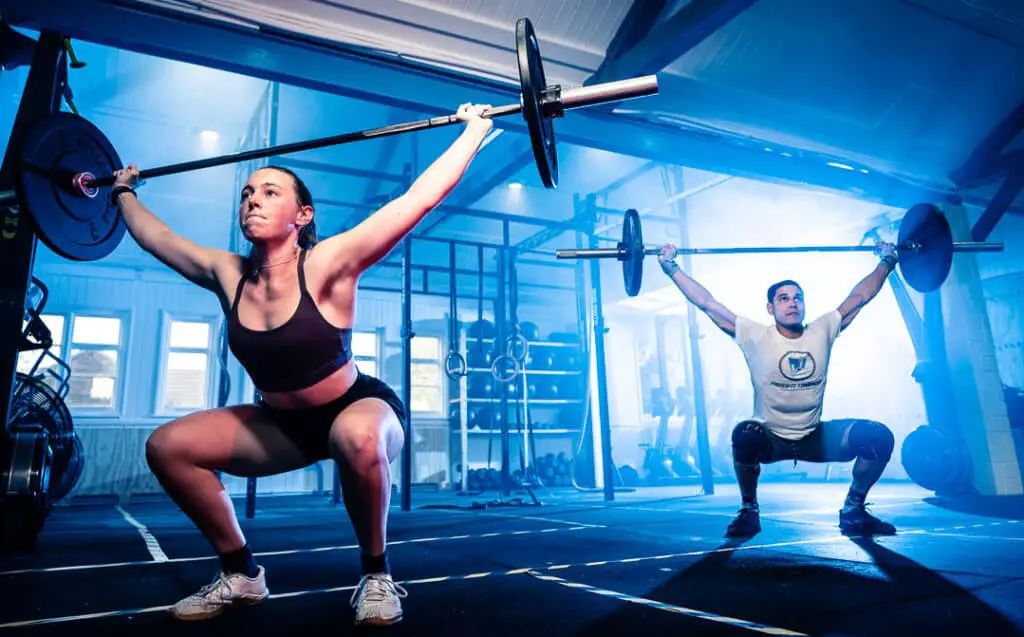
Other examples of usefulness with flexibility might be anything overhead with a barbell.
Overhead squats, overhead lunges, front rack lunch and front squats are used often in CrossFit classes.
Furthermore, so do gymnastics movements. Planche push-ups, toes to bar, muscle ups, wall walks – much of it can be beneficial to have good flexibility.
So the overall conclusion on flexibility is that the more you have it the more mobile you are, and the better you’ll become at CrossFit and Yoga.
Strength
It goes without saying strength firmly crosses over into your CrossFit.
Entire sections of the class are dedicated to improving strength.
So the aim is to be able to lift more weight, and within yoga young is to be able to hold your body weight in difficult positions and hold it for longer.
My experience is that it’s a different kettle of fish being able to squat heavy or put over 100kg over your head than it is to hold a difficult Yoga pose for a protracted period.
As your balance improves from doing difficult holds for long periods of time, you learn how to control your balance and learn more spatial and bodily awareness.
No pains no gains
They both hurt but in different ways. The crossover though is it helps your mind. Something that’s heavy or holding a stance in a stress position requires strength.
Strength is not only a physical concept. It’s also very much in the mind, as your mind drives your body.
So if you’re strong in mind you can also be stronger in body.
It’s safe to conclude that it is good for physical and mental strength doing both CrossFit and Yoga.
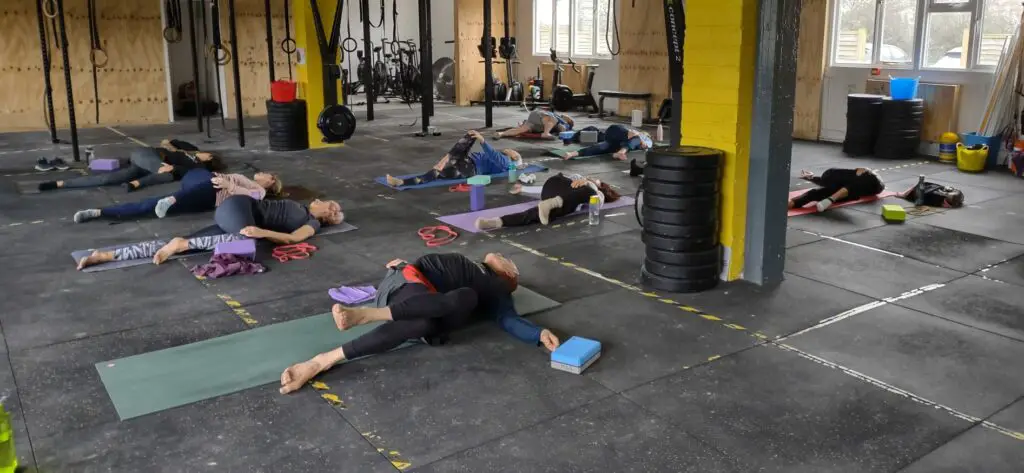
Balance
Standing in awkward positions to the point of your body quivers requires a heightened level of balance.
This is yoga all over.
As your balance improves from doing difficult holds for long periods of time, you learn how to control your balance and learn more spatial and bodily awareness.
Of course, this will help improve CrossFit as much of it relies on good balance.
Challenging positons
For instance, you need excellent balance with an overhead squat. Or again, the Olympic lifts rely heavily on good balance.
If you’re putting heavy weight overhead in the Snatch or the Jerk, balance is key in maintaining good form, good posture, and a good lift.
Bad balance results in bad form, bad posture and ultimately a bad or failed lift.
By improving your balance in Yoga you’ll be improving your balance in general which feeds into many parts of CrossFit.
Agility
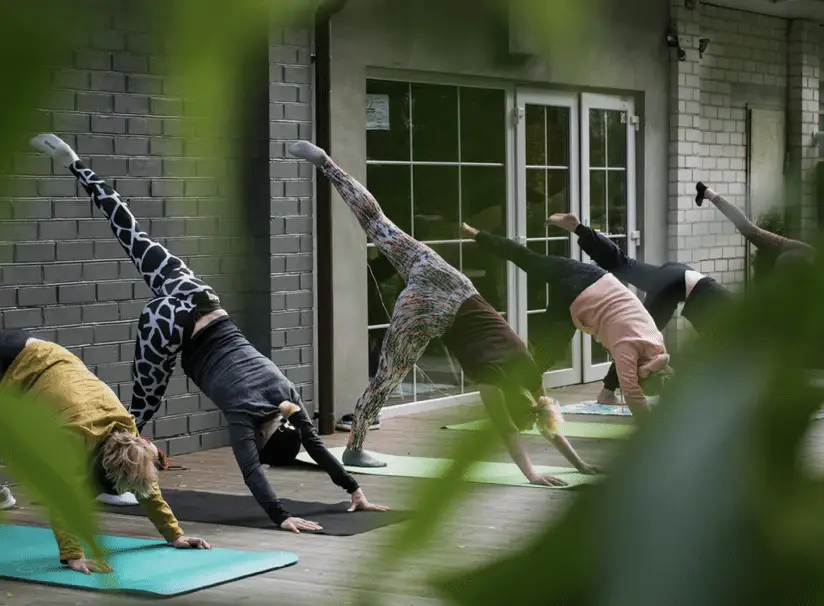
Being agile or nimble is important in CrossFit.
Many of the elite athletes are absolutely stacked with muscle, yet they are able to do agile movements such as walking on their hands under for long distances under fatigue.
Having good agility enables you to control your body in difficult situations, especially when you are under duress such as in a stress position. You are more capable of controlling your body, doing what you want it to do.
In Yoga, this is key as you go from pose to pose, position to position. Your agility comes into play as you navigate the class.
If you’re putting heavy weight overhead in the Snatch or the Jerk, balance is key in maintaining good form, good posture, and a good lift.
Nimble business
CrossFit it’s not all about brute strength ripping a Deadlift off the floor. Though strength is useful, moving around on a gymnastics ring in a controlled fashion is also very important.
Therefore, agility applies very much to Yoga and CrossFit in a variety of ways.
Coordination
Similar to agility, coordination again is important in many movements at CrossFit. Likewise, it’s fundamental to many movements in yoga.
Having good coordination enables successful execution of the movements in a safe and controlled manner.
Putting together the Snatch – one of the most technical movements in CrossFit – is sometimes mindbogglingly hard, especially those starting out.
It takes so many years of practice to refine the technique and style that is yours.
Breaking the lift down into bite-size chunks is useful. Building it up to one smooth movement takes a lot of time and coordination.
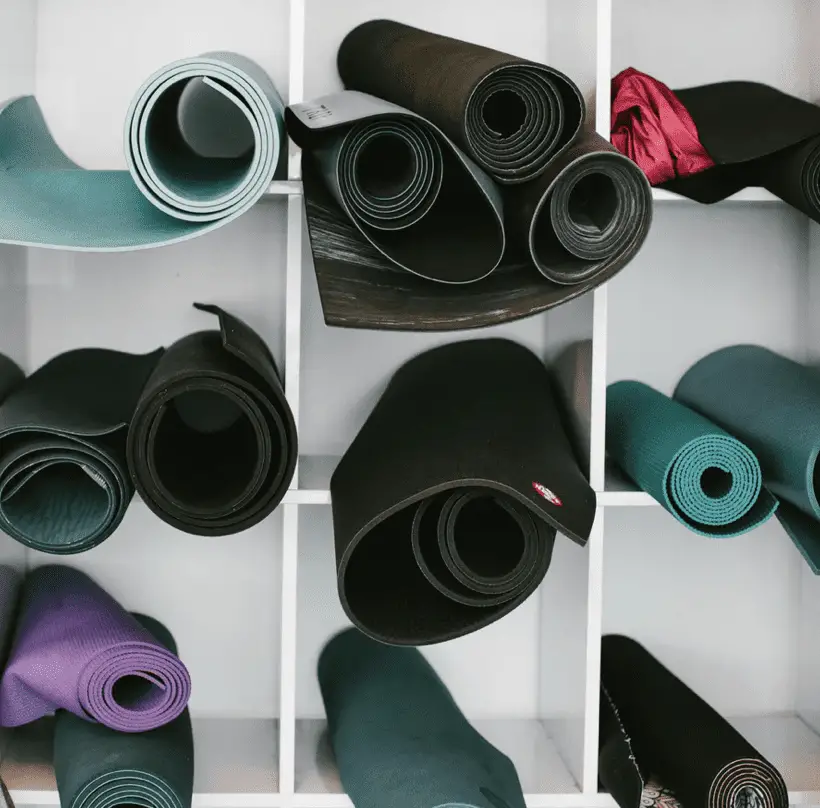
So having good coordination even just for the Snatch – which is very prevalent in the sport – is highly important.
Likewise, if your coordination is on the poorer side, in yoga you may struggle with taking commands during the class and carrying them out successfully. Improved co-ordination is good.
Articulating our bodies in different and uncomfortable ways is common in Yoga and CrossFit.
Minute correctiveness
We’ve all fallen over in a yoga class and it’s nothing new. However, having good coordination helps reduce failure of movements.
Co-ordination, then, is central to both CrossFit and Yoga, as it’s all built around movements we don’t normally do in everyday life, some of which require additional thought when learning.
Articulating our bodies in different and uncomfortable ways is common in Yoga and CrossFit.
Accuracy
When talking about accuracy this does not mean necessarily a target and a rifle for example.
Although that may be improved, having better accuracy is a ‘fitter human’ in the ten-domain sense.
So the more accurate we are, the more skilled we become in Yoga and in CrossFit.
Be on target
We need good accuracy when carrying out there is 150 Wall Balls, to maximise efficiency, for example. Or we need accuracy when lunging forward into Warrior 2 pose under fatigue.
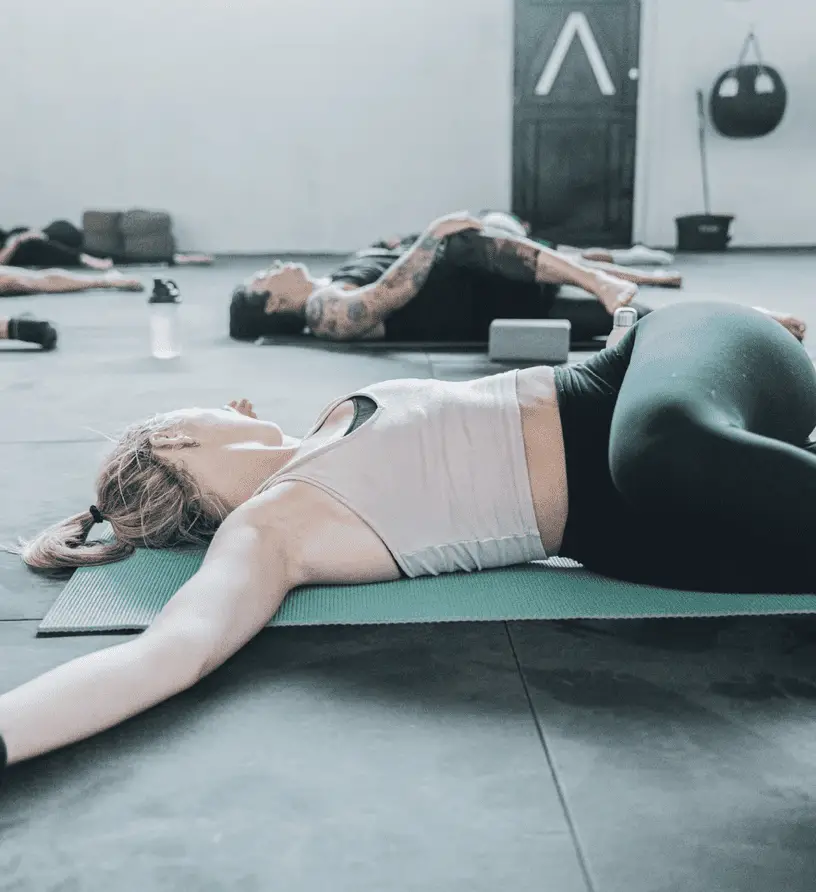
Being accurate when given a command in a Yoga class and dropping into the position that your brain is trying to get you into has a huge benefit when we apply it to CrossFit.
It’s not just targets of wall which require accuracy. Nor is it just the Olympic lifts too.
Movements such as Double Unders (skipping ropes passes twice underfoot at each pass), which are an annoyance and the holy Grail for many aspiring CrossFitters affords a great deal accuracy (and agility).
It’s all about timing and wrist mobility. The timing relies on accuracy. A subconscious accuracy.
So the more accurate we are, the more skilled we become in Yoga and in CrossFit.
How does Yoga improve CrossFit?
The same way CrossFit improves Yoga, Yoga improves CrossFit.
As one improves, so can the other by virtue of the fact that you become more refined in one of the domains.
As a result, the refined domain directly correlates to an improved skill level in CrossFit. This article will show you what CrossFit Level you are.
Learn faster
You will be able to pick up skills quicker. Don’t be surprised if you can find yourself better able to achieve deeper squat depth or a more comfortable front rack.
By going through uncomfortable stress positions in your Yoga class which requires a great deal of flex, may mean you’ll get that level up on your Overhead Squat.
You get used to that uncomfortable feeling in Handstand Scorpion, so walking on your hands under fatigue is less of a big deal!
Reducing tightness and DOMS
Doing CrossFit pushes your body extracting the most from your body. We all should be stretching and warming down after class.
DOMS stands for Delayed Onset Muscle Strain and is the tightness felt after physical exercise. This might be tight quads after a squat session, or maybe tight trap softer volume to pull ups.
Yoga is great for loosening up and getting fresh blood to those tight muscles. It’s a low-impact way of de-tightening and distressing the body.
Loosen off
There have been times when I have gone to CrossFit and not done the main WOD (workout of the day) because of tightness. So I have opted for mobility and stretching in the corner instead.
I’ve also opted for the Yoga class due to being tight and restricted by DOMS
Yoga is a great remedy for tight muscles.
Increased mobility and Range of Motion (ROM)
This was touched upon earlier under the heading flexibility.
Range of motion is extremely important in many movements within CrossFit. It is also extremely important in many movements within Yoga.
Having a good range of motion (ROM) means that movements will come easier and you will learn faster.
The benefit is that you become more mobile. Also, your joints and muscles improve their functionality.
The better your ROM, the more skilled you can become, and on a quicker timescale.
Less Injuries
Having less niggles is only a good thing!
CrossFit is the yin to that yang. Doing Yoga – and becoming better at it – means that you’re less likely to pick up injury. You can reduce any soreness from CrossFit (DOMS) by doing Yoga. Win win.

Breath control
This is important in both activities. Breath control helps stabilise and improve your concentration in a difficult pose in your Yoga class. Your instructor will often cue or remind us to breathe.
Breath control will help you get through movements such as Thrusters (rapid Front Squat with explosive Push Press).
Being able to concentrate on our breathing in a conscious or subconscious manner is important to both activities.
By mastering your breath control, you will be able to extract more from both your CrossFit and Yoga classes.
How often should I do Yoga when CrossFitting?
A good benchmark if you prefer Crossfit over Yoga, then 3 to 4 sessions for CrossFit and 1 Yoga session per week.
Conversely, if you prefer to do Yoga, then 2 to 3 Yoga sessions and 1 to 2 CrossFit sessions are a good balance.
If you can get at least one Yoga (or mobility) session into your week’s training, this would be ideal.
Optimum sessions
2 CrossFit sessions is preferable either way, as there is much to learn.
By doing one class per week it will be very difficult for you to improve in a desirable manner. This article shows you more about this.
The survey we carried out in a affiliates demonstrated that 3 to 4 sessions are very popular, with many doing 5+.
The least quantity of our members do 1 per week, which is good because it’s hard to really benefit from a CrossFit at this regularity.
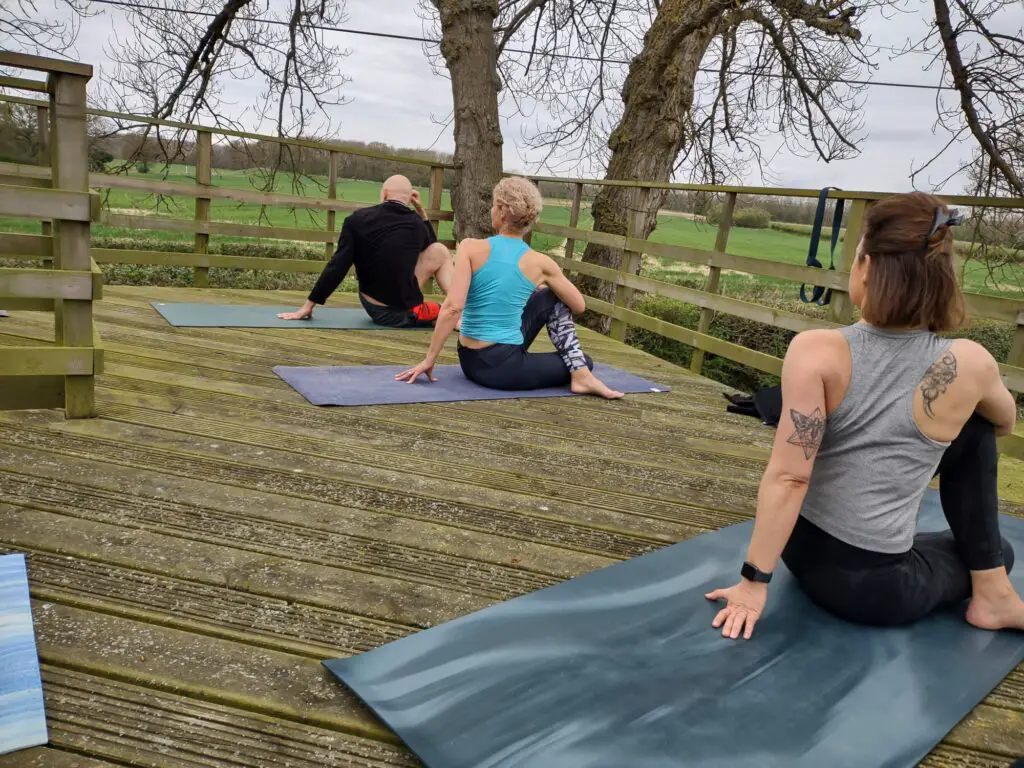
However, at least 1 Yoga session per week whilst doing alongside CrossFit is still very beneficial.
There is less to learn and much to be gained from doing one Yoga sesh per week. Things such as reducing soreness increase the blood flow to muscles, and generally a slower pace of exercise.
So, if you can get at least one Yoga (or mobility) session into your week’s training, this would be ideal.
Where can I do Yoga?
There are many high street yoga establishments everywhere. It is now very commonplace.
It’s not just yummy mummies or rich American folk doing it.
Prior to that, hailing from the east it was a pastime and prerequisite for the Eastern spiritual clans.
Yoga is now for everyone and anyone. It was originally a mind and body experience, much of it underpinned by spiritualism. However, today it is a mainstream activity, carried out by a whole range of people.
The first place to look would be your own CrossFit gym
Many CrossFit Affiliates offer Yoga as part of the timetable, or even a proprietary mobility class which is similar.
If your CrossFit gym doesn’t offer Yoga, then ask your coach if they know of anybody or anywhere that’s recommended nearby. Chances are some of the members at your gym already do yoga, and so it’s within the realm of recommendation.
Generally, spaces don’t need to be large. My wife used to do 1 class per week in a lady’s front room, which at a push fitted the instructor and six people!
When you find a Yoga establishment, make sure you speak to them first about which class to attend as they may have a variety of levels/styles. They will be able to tell you which one would suit you best.
Ensure that you tell them you are also doing CrossFit as it may help give them a bearing on which class you should attend.
Good luck and enjoy doing both activities!
